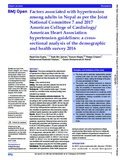Factors associated with hypertension among adults in Nepal as per the Joint National Committee 7 and 2017 American College of Cardiology/American Heart Association hypertension guidelines: A cross-sectional analysis of the demographic and health survey 2016

View/Open
Date
2019-08-10Publisher
BMJ JournalsAuthor
Gupta, Rajat DasBin Zaman, Sojib
Wagle, Kusum
Crispen, Reese
Hashan, Mohammad Rashidul
Al Kibria, Gulam Muhammed
Metadata
Show full item recordCitation
Das Gupta, R., Bin Zaman, S., Wagle, K., Crispen, R., Hashan, M. R., & Al Kibria, G. M. (2019). Factors associated with hypertension among adults in Nepal as per the Joint National Committee 7 and 2017 American College of Cardiology/American Heart Association hypertension guidelines: a cross-sectional analysis of the demographic and health survey 2016. BMJ open, 9(8), e030206. https://doi.org/10.1136/bmjopen-2019-030206Abstract
Objectives: This study investigated the determinants of hypertension in Nepal according to both the Joint National Committee 7 (JNC7) and the American College of Cardiology/American Heart Association (2017 ACC/AHA) guidelines.
Design: Cross-sectional study.
Setting: This study used data collected from the 2016 Nepal Demographic and Health Survey data.
Participants: 13 393 weighted adults aged ≥18 years enrolled by a stratified cluster sampling strategy were included in our analysis.
Primary and secondary outcome measures: The primary outcome was hypertension, which was defined according to JNC7 (systolic blood pressure (SBP) ≥140 mm Hg and/or diastolic blood pressure (DBP) ≥90 mm Hg) and 2017 ACC/AHA guidelines (SBP ≥130 mm Hg and/or DBP ≥80 mm Hg). Antihypertensive medication users were also classified as hypertensive. After descriptive analysis, multilevel logistic regression was applied to obtain ORs.
Results: About 21% (n=2827) and 44% (n=5918) of the individuals aged ≥18 years were classified as hypertensive according to the JNC7 and 2017 ACC/AHA guidelines, respectively. Following factors were found to be significantly associated with hypertension according to the 2017 ACC/AHA guideline: ≥70 years (adjusted OR (AOR) 5.2; 95% CI 4.3 to 6.2), 50-69 years (AOR 3.9; 95% CI 3.4 to 4.4) and 30-49 years (AOR 2.7; 95% CI 2.4 to 3.0) age groups, male gender (AOR 1.7; 95% CI 1.6 to 1.9), being overweight/obese (AOR 3.0; 95% CI 2.7 to 3.3), residence in provinces 4 (AOR 1.5; 95% CI 1.2 to 2.0) and 5 (AOR 1.5; 95% CI 1.2 to 1.9). No significant association was identified with household wealth status and ecological regions of residence using the 2017 ACC/AHA guideline.
Conclusions: Per both guidelines, multiple factors were associated with hypertension. Public health programme aiming to prevent and control hypertension in Nepal should prioritise these factors and focus on individuals with a higher likelihood of hypertension irrespective of educational level, household wealth status and ecological regions of residence.
